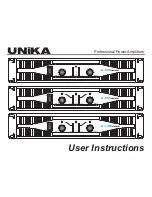
page 39
Reference Manual
IQ-PIP-USP3/CN
This procedure should work well for most applications. However, some applications can be
a little more difficult. Some very low-level and/or low duty-cycle signals may not ade-
quately “test” the load. Lab and situation testing have shown output levels as small 40 dB
below rated amplifier output to be enough for most low-impedance loads. Higher imped-
ance loads such as those used in “lightly-loaded” 70V distribution lines may require signal
level near 20 dB below rated output.
The “Nominal Load Impedance” control is used to optimize the system for the most accu-
rate calculation of load impedance. It should be set to the expected nominal (or rated)
impedance of the “normal” load. The high limit should be set for at least 2 times the
expected nominal or actual measured load, while the low limit should be set to ½ the
expected nominal or actual measured load.
The following example calculates the SPL necessary for supervision of a typical 8-ohm
system. While the resulting 80-dB SPL @ 1 meter is definitely above conversation level, it
is not uncomfortable.
An “8 ohm” example:
30 mA into 8 ohms = 0.007watts
8-ohm driver sensitivity = 100dB for 1W @ 1 meter
0.007W/1W = –20dB
Required SPL for supervision test is 100dB – 20dB = 80dB SPL @ 1 meter
6.2.1 Typical Load Characteristics
It is well known that the typical loudspeaker impedance is not the same for all frequencies.
This variance is due to the effect of electrical properties such as the expected increase in
impedance at high frequencies due to driver voice-coil inductance, or the peaks and valleys
due to passive crossovers. Testing of various passive boxes has shown peaks of 100 ohms
or more! Low-frequency impedance variation can come from the interaction of the driver
compliance with that of the box. The low frequency variations are usually wide bandwidth
and may vary from 6 to 30 ohms on an 8-ohm driver.
These anomalies are easily averaged out by the IQ-PIP-USP3/CN supervision algorithm in
most systems. However, there may be some extreme situations for very narrow bandwidth
(i.e. single-note) signals and/or very widely varying loads that the algorithm simply cannot
overcome. In these cases, widening the high and low limits will help decrease the “sensitiv-
ity” of supervision and decrease the chance of “nuisance” error reports.
Summary of Contents for IQ-PIP-USP3
Page 46: ...This page intentionally left blank ...
Page 48: ......










































